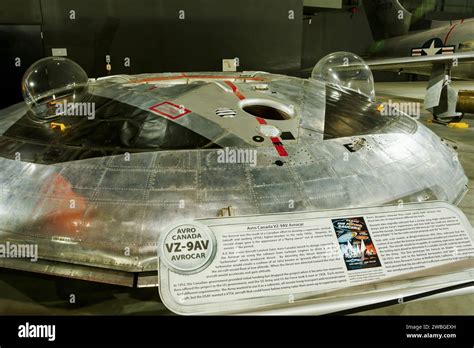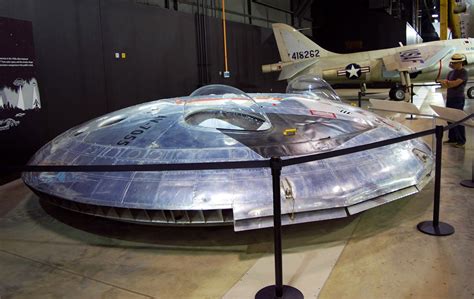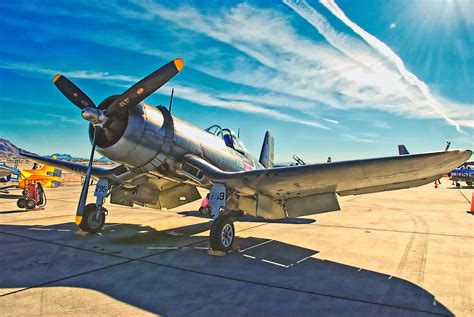The Avro Canada VZ-9AV Avrocar was a revolutionary, albeit short-lived, experimental aircraft developed in the late 1950s by Avro Canada, a leading Canadian aircraft manufacturer at the time. This intriguing project aimed to create a vertical takeoff and landing (VTOL) aircraft that could transition into a high-speed, horizontal flight mode, leveraging the principles of the Coandă effect to generate lift and thrust. The Avrocar's design was a radical departure from conventional aircraft, with a saucer-like shape and a single, large fan located at its center, which was intended to provide both lift and propulsion.
Design and Development

The Avrocar project began in 1952, with the goal of creating an aircraft that could fulfill a variety of roles, from reconnaissance to combat missions, without the need for runways. The design team, led by John Frost, envisioned an aircraft that could hover, take off, and land vertically, and then transition into high-speed forward flight. The key to achieving this was the use of a ducted fan, which would blow air downward to create lift and, by redirecting the airflow, provide forward thrust. This concept was novel and presented significant technical challenges, including stability, control, and the management of airflow around the aircraft.
Aerodynamic Challenges and Solutions
One of the primary challenges faced by the Avrocar’s designers was understanding and harnessing the Coandă effect, a phenomenon where a fluid (in this case, air) tends to follow a nearby surface and bend around it. The Avrocar’s shape was designed to maximize this effect, with the air blown by the central fan following the curved surface of the aircraft to enhance lift. However, managing this airflow and ensuring stable, controlled flight proved to be more complex than anticipated. The team had to develop innovative solutions to stabilize the airflow and ensure the aircraft could maintain level flight, including the use of control vanes and careful shaping of the aircraft’s body.
| Technical Specification | Value |
|---|---|
| Length | 18 feet (5.5 meters) |
| Diameter | 18 feet (5.5 meters) |
| Height | 5.5 feet (1.7 meters) |
| Empty Weight | 5,000 pounds (2,268 kilograms) |
| Powerplant | 3 Continental J69-T-9 turbojet engines |
| Maximum Speed | 300 mph (483 km/h) (estimated) |

Testing and Outcome

Testing of the Avrocar began in 1959, with the first prototype, the VZ-9AV-1, undergoing tethered flights to evaluate its stability and control characteristics. While these initial tests showed promise, with the aircraft able to hover and move slowly, it became clear that achieving high-speed transition and stable flight would require significant advancements in control systems and aerodynamic design. Unfortunately, before these challenges could be fully addressed, the project was canceled in 1961 due to budget constraints and the realization that the technology of the time was not yet advanced enough to overcome the inherent design and stability issues.
Key Points
- The Avrocar was an experimental VTOL aircraft designed to use the Coandă effect for lift and thrust.
- It was developed by Avro Canada in the late 1950s with the goal of creating an aircraft capable of vertical takeoff and landing, as well as high-speed horizontal flight.
- The project faced significant technical challenges, including stability and control issues, and was ultimately canceled in 1961.
- Despite its failure, the Avrocar contributed to the development of VTOL technology and remains an interesting footnote in the history of aviation innovation.
- The Avrocar's design, though radical, underscored the complexities of aerodynamics and the need for continued research and development in aviation technology.
Legacy and Impact
The Avrocar, though not successful in its intended role, has a lasting legacy in the field of aviation. Its development and the challenges it posed contributed to the advancement of VTOL technology, influencing later projects such as the Harrier jump jet and contemporary drones and hovercraft. The lessons learned from the Avrocar’s aerodynamic and stability issues have also informed the design of more recent VTOL aircraft, including those intended for military and civilian use. Today, the Avrocar is remembered as a pioneering effort in the pursuit of innovative flight technologies, a testament to the ingenuity and vision of its designers.
What was the primary goal of the Avrocar project?
+The primary goal was to develop a VTOL aircraft capable of high-speed horizontal flight, utilizing the Coandă effect for lift and propulsion.
What were some of the significant challenges faced by the Avrocar's designers?
+Key challenges included managing airflow for stability and control, achieving high-speed transition, and overcoming the technical limitations of the time.
What is the legacy of the Avrocar in aviation history?
+The Avrocar contributed to the development of VTOL technology, influencing later aircraft designs and informing the solution of aerodynamic and stability issues in contemporary VTOL craft.
In conclusion, the Avro Canada VZ-9AV Avrocar represents a fascinating chapter in the history of aviation innovation, showcasing both the ambition of its designers and the complexities of pushing the boundaries of flight technology. Though the project itself did not achieve its goals, its impact on the development of VTOL aircraft and the understanding of aerodynamic principles has been lasting, inspiring future generations of engineers and aviation enthusiasts alike.



